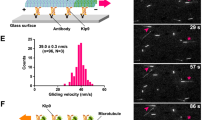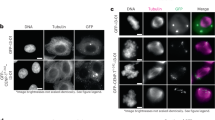Abstract
During anaphase identical sister chromatids separate and move towards opposite poles of the mitotic spindle1,2. In the spindle, kinetochore microtubules3 have their plus ends embedded in the kinetochore and their minus ends at the spindle pole. Two models have been proposed to account for the movement of chromatids during anaphase. In the ‘Pac-Man’ model, kinetochores induce the depolymerization of kinetochore microtubules at their plus ends, which allows chromatids to move towards the pole by ‘chewing up’ microtubule tracks4,5. In the ‘poleward flux’ model, kinetochores anchor kinetochore microtubules and chromatids are pulled towards the poles through the depolymerization of kinetochore microtubules at the minus ends6. Here, we show that two functionally distinct microtubule-destabilizing KinI kinesin enzymes (so named because they possess a kinesin-like ATPase domain positioned internally within the polypeptide) are responsible for normal chromatid-to-pole motion in Drosophila. One of them, KLP59C, is required to depolymerize kinetochore microtubules at their kinetochore-associated plus ends, thereby contributing to chromatid motility through a Pac-Man-based mechanism. The other, KLP10A, is required to depolymerize microtubules at their pole-associated minus ends, thereby moving chromatids by means of poleward flux.
This is a preview of subscription content, access via your institution
Access options
Subscribe to this journal
Receive 51 print issues and online access
$199.00 per year
only $3.90 per issue
Buy this article
- Purchase on Springer Link
- Instant access to full article PDF
Prices may be subject to local taxes which are calculated during checkout




Similar content being viewed by others

References
Mitchison, T. J. & Salmon, E. D. Mitosis: a history of division. Nature Cell Biol. 3, E17–E21 (2001)
Wittmann, T., Hyman, A. & Desai, A. The spindle: a dynamic assembly of microtubules and motors. Nature Cell Biol. 3, E28–E34 (2001)
Rieder, C. L. & Salmon, E. D. The vertebrate cell kinetochore and its roles during mitosis. Trends Cell Biol. 8, 310–318 (1998)
Mitchison, T. J., Evans, L., Schulze, E. & Kirschner, M. Sites of microtubule assembly and disassembly in the mitotic spindle. Cell 45, 515–527 (1986)
Gorbsky, G. J., Sammak, P. J. & Borisy, G. G. Chromosomes move poleward in anaphase along stationary microtubules that coordinately disassemble from their kinetochore ends. J. Cell Biol. 104, 9–18 (1987)
Mitchison, T. J. Polewards microtubule flux in the mitotic spindle: evidence from photoactivation of fluorescence. J. Cell Biol. 109, 637–652 (1989)
Hunter, A. W. & Wordeman, L. How motor proteins influence microtubule polymerization dynamics. J. Cell Sci. 24, 4379–4389 (2000)
Wordeman, L. & Mitchison, T. J. Identification and partial characterization of mitotic centromere-associated kinesin, a kinesin-related protein that associates with centromeres during mitosis. J. Cell Biol. 128, 95–104 (1995)
Walczak, C. E., Mitchison, T. J. & Desai, A. XKCM1: a Xenopus kinesin-related protein that regulates microtubule dynamics during mitotic spindle assembly. Cell 84, 37–47 (1996)
Desai, A., Verma, S., Mitchison, T. J. & Walczak, C. E. KinI kinesins are microtubule-destabilizing enzymes. Cell 96, 69–78 (1999)
Maney, T., Hunter, A. W., Wagenbach, M. & Wordeman, L. Mitotic centromere-associated kinesin is important for anaphase chromosome segregation. J. Cell Biol. 142, 787–801 (1998)
Kline-Smith, S. L. & Walczak, C. E. The microtubule-destabilizing kinesin XKCM1 regulates microtubule dynamic instability in cells. Mol. Biol. Cell 13, 2718–2731 (2002)
Walczak, C. E., Gan, E. C., Desai, A., Mitchison, T. J. & Kline-Smith, S. L. The microtubule-destabilizing kinesin XKCM1 is required for chromosome positioning during spindle assembly. Curr. Biol. 12, 1885–1889 (2002)
Goldstein, L. S. B. & Gunawardena, S. Flying through the Drosophila cytoskeletal genome. J. Cell Biol. 150, F63–F68 (2000)
Sullivan, W. & Theurkauf, W. E. The cytoskeleton and morphogenesis of the early Drosophila embryo. Curr. Opin. Cell Biol. 7, 18–22 (1995)
Sullivan, W., Fogarty, P. & Theurkauf, W. E. Mutations affecting the cytoskeletal organization of syncytial Drosophila embryos. Development 118, 1245–1254 (1993)
Waterman-Storer, C. M., Desai, A., Bulinski, J. C. & Salmon, E. D. Fluorescent speckle microscopy, a method to visualize the dynamics of protein assemblies in living cells. Curr. Biol. 8, 1227–1230 (1998)
Brust-Mascher, I. & Scholey, J. M. Microtubule flux and sliding in mitotic spindles of Drosophila embryos. Mol. Biol. Cell 13, 3967–3975 (2002)
Maddox, P., Desai, A., Oegema, K., Mitchison, T. J. & Salmon, E. D. Poleward microtubule flux is a major component of spindle dynamics and anaphase A in mitotic Drosophila embryos. Curr. Biol. 12, 1670–1674 (2002)
Waters, J. C., Mitchison, T. J., Rieder, C. L. & Salmon, E. D. The kinetochore microtubule minus-end disassembly associated with poleward flux produces a force that can do work. Mol. Biol. Cell 7, 1547–1558 (1996)
Sharp, D. J., Rogers, G. C. & Scholey, J. M. Cytoplasmic dynein is required for poleward chromosome movement during mitosis in Drosophila embryos. Nature Cell Biol. 2, 922–930 (2000)
Troxell, C. L. et al. pkl1+ and klp2+: Two kinesins of the Kar3 subfamily in fission yeast perform different functions in both mitosis and meiosis. Mol. Biol. Cell 12, 3476–3488 (2001)
West, R. R., Malmstrom, T., Troxell, C. L. & McIntosh, J. R. Two related kinesins, klp5+ and klp6+, foster microtubule disassembly and are required for meiosis in fission yeast. Mol. Biol. Cell 12, 3919–3932 (2001)
West, R. R., Malmstrom, T. & McIntosh, J. R. Kinesins klp5+ and klp6+ are required for normal chromosome movement in mitosis. J. Cell Sci. 115, 931–940 (2002)
Garcia, M. A., Koonrugsa, N. & Toda, T. Two kinesin-like KinI family proteins in fission yeast regulate the establishment of metaphase and the onset of anaphase. Curr. Biol. 12, 610–621 (2002)
Rogers, S. L., Rogers, G. C., Sharp, D. J. & Vale, R. D. Drosophila EB1 is important for proper assembly, dynamics, and positioning of the mitotic spindle. J. Cell Biol. 158, 873–884 (2002)
Bousbaa, H., Correia, L., Gorbsky, G. J. & Sunkel, C. E. Mitotic phosphoepitopes are expressed in Kc cells, neuroblasts and isolated chromosomes of Drosophila melanogaster. J. Cell Sci. 110, 1979–1988 (1997)
Sharp, D. J., Yu, K. R., Sisson, J. C., Sullivan, W. & Scholey, J. M. Antagonistic microtubule-sliding motors position mitotic centrosomes in Drosophila early embryos. Nature Cell Biol. 1, 51–54 (1999)
Valdes-Perez, R. E. & Minden, J. S. Drosophila melanogaster syncytial nuclear divisions are patterned: time-lapse images, hypothesis and computational evidence. J. Theor. Biol. 175, 525–532 (1995)
McIntosh, J. R., Grishchuk, E. L. & West, R. R. Chromosome-microtubule interactions during mitosis. Annu. Rev. Cell Dev. Biol. 18, 193–219 (2002)
Acknowledgements
We would like to thank B. Kenigsberg, D. Buster, P. Baas, F. McNally, A. Asenjo and H. Sosa for critically reading the manuscript; I. Brust-Mascher for advice on FSM; and A. Desai and J. Minden for help with rhodamine-histone preparations. We also thank C. Sunkel for providing GFP-Polo kinase flies and protocols for isolating mitotic chromosomes. We are grateful to the following individuals for their gifts: GFP–tubulin flies from A. Spradling; GFP-DTACC flies from J. Raff; GFP–Rod flies from R. Karess; GFP-Cid flies from S. Henikoff; and G. Karpen for the anti-Cid antibody. We thank G. Law, P. Franklin and R. Sleeper (PerkinElmer) for their assistance with the Ultraview confocal microscope. This work was supported by grants from the National Institutes of Health to D.J.S., C.E.W, R.D.V. and J.M.S.. C.E.W is a Scholar of the Leukemia and Lymphoma Society.
Author information
Authors and Affiliations
Corresponding author
Ethics declarations
Competing interests
The authors declare that they have no competing financial interests.
Supplementary information
41586_2004_BFnature02256_MOESM17_ESM.zip
Supplementary Movie 1: 4-D (xyz/time) movie of mitosis in a control-injected syncytial blastoderm-stage embryo expressing GFP-tubulin. (ZIP 1220 kb)
41586_2004_BFnature02256_MOESM18_ESM.mov
Supplementary Movie 2: 4-D movie showing mitosis in a control-injected embryo containing GFP-histones (green) and rhodamine-tubulin (red). (MOV 1259 kb)
41586_2004_BFnature02256_MOESM20_ESM.mov
Supplementary Movie 4: 4-D movie from anti-KLP10A antibody-injected embryo containing GFP-histones (green) and rhodamine-tubulin (red). (MOV 1737 kb)
41586_2004_BFnature02256_MOESM21_ESM.zip
Supplementary Movie 5: 4-D movie from an anti-KLP59C antibody-injected embryo containing GFP-histones (green) and rhodamine-tubulin (red). (ZIP 1116 kb)
41586_2004_BFnature02256_MOESM22_ESM.zip
Supplementary Movie 6: FSM movie showing microtubule-behaviors in spindles from a control-injected embryo. (ZIP 1156 kb)
41586_2004_BFnature02256_MOESM23_ESM.zip
Supplementary Movie 7: FSM movie showing microtubule behaviors in a spindle from an anti-KLP10A antibody-injected embryo. (ZIP 1197 kb)
Rights and permissions
About this article
Cite this article
Rogers, G., Rogers, S., Schwimmer, T. et al. Two mitotic kinesins cooperate to drive sister chromatid separation during anaphase. Nature 427, 364–370 (2004). https://doi.org/10.1038/nature02256
Received:
Accepted:
Published:
Issue Date:
DOI: https://doi.org/10.1038/nature02256
This article is cited by
-
Mechanisms underlying spindle assembly and robustness
Nature Reviews Molecular Cell Biology (2023)
-
Suppression of Patronin deficiency by altered Hippo signaling in Drosophila organ development
Cell Death & Differentiation (2021)
-
NuMA regulates mitotic spindle assembly, structural dynamics and function via phase separation
Nature Communications (2021)
-
The role of Patronin in Drosophila mitosis
BMC Molecular and Cell Biology (2019)
-
Microtubule minus-end regulation at spindle poles by an ASPM–katanin complex
Nature Cell Biology (2017)
Comments
By submitting a comment you agree to abide by our Terms and Community Guidelines. If you find something abusive or that does not comply with our terms or guidelines please flag it as inappropriate.


